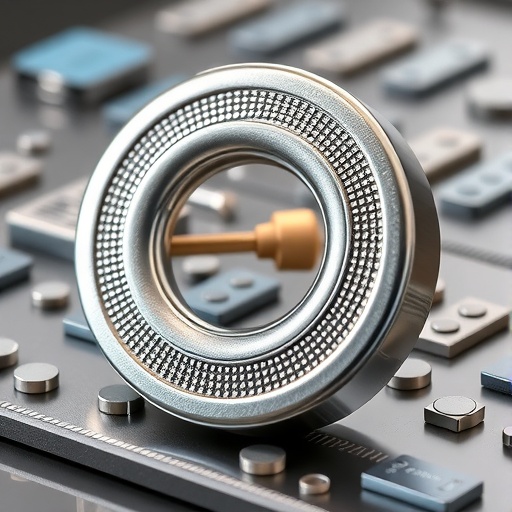In a groundbreaking advance that could reshape the future of magnetic technologies, researchers at North Carolina State University have unveiled a revolutionary manufacturing technique for producing strong permanent magnets. This innovative process not only boosts the quality and uniformity of magnets but also drastically cuts production time, energy use, and manufacturing costs, addressing long-standing challenges in the production of high-performance magnetic materials crucial for modern technology.
Permanent magnets constitute the backbone of numerous emerging technologies, from electric vehicles and wind turbines to robotics and consumer electronics. The escalating demand for these powerful magnets has strained conventional manufacturing methods, which struggle to reconcile the need for superior magnetic properties with efficiency and sustainability. Traditional approaches rely heavily on sintering metal alloy powders under intense heat and pressure, a method beset by complexity, energy consumption, and material imperfections.
The lead author and assistant professor of materials science and engineering, Bharat Gwalani, highlights the inherent limitations of standard sintering techniques. “Conventional magnet manufacturing involves compressing and heating alloy powders into solid forms at high temperatures and pressures exceeding 100 megapascal,” Gwalani explains. “This process is not only complicated and energy-intensive but frequently results in magnets with uneven porosity and suboptimal magnetic properties, particularly with increased porosity concentrated at the core.”
.adsslot_n72Er8iSoB{width:728px !important;height:90px !important;}
@media(max-width:1199px){ .adsslot_n72Er8iSoB{width:468px !important;height:60px !important;}
}
@media(max-width:767px){ .adsslot_n72Er8iSoB{width:320px !important;height:50px !important;}
}
ADVERTISEMENT
Porosity — the presence of microscopic voids within the magnet material — undermines magnetic uniformity and strength. Unequal distribution of these pores compromises magnet performance, introducing weaknesses that can impact reliability and lifespan. Moreover, the reliance on rare earth metals in these magnets—which are highly reactive to oxygen—adds further complications. Exposure to oxygen during the high-heat sintering accelerates oxidation, deteriorating the magnetic performance.
Addressing these challenges, the research team pioneered a new approach rooted in friction stir consolidation (FSC), a technique originally developed for metallurgical joining and shaping. FSC involves placing alloy powders into a chamber where a rotating tool applies pressure while stirring the powder bed. The mechanical energy generated during rotation consolidates the powder into solid bulk without reaching melting temperatures, a key distinction from traditional sintering.
“The beauty of friction stir consolidation lies in its ability to circumvent the thermal exposure that triggers oxidation and undesired phase transformations,” Gwalani remarks. “Our process applies pressures below one megapascal—substantially less than the norms—while frictional heating at the exact interface of powder particles fuses them together, preserving the alloy’s integrity and yielding a uniform, dense magnet.”
Unlike unidirectional pressure in traditional methods which concentrates force at the top and bottom faces, FSC induces an omnidirectional pressure distribution owing to the rotational stirring. This dynamic pressure environment effectively eliminates porosity by preventing pore entrapment at the center of the material. The result is a dense, flaw-free magnetic composite with homogenous microstructure and superior magnetic properties throughout.
Furthermore, because FSC generates heat internally through friction between powder particles, the bulk material does not endure harsh external heating. This localized thermal input means oxidation rates are significantly reduced compared to ovens or furnaces used in sintering. Preserving the delicate rare earth elements in their optimum state yields a magnet with enhanced coercivity and remanence—crucial parameters for high-performance applications.
This newly developed technique offers several transformative benefits: faster production cycles that could accelerate scaling to industrial levels, reduced energy usage contributing to sustainability goals, and cost savings by minimizing material waste and simplifying manufacturing requirements. These factors together create a compelling case for FSC as the future standard for permanent magnet fabrication.
Having successfully demonstrated the FSC process with samarium-cobalt (Sm-Co) powders—materials renowned for their exceptional magnetic strength and thermal stability—the team is already venturing into exploratory research for next-generation magnetic materials. They aim to incorporate non-magnetic binders to fabricate magnets that are lighter, tougher, and less dependent on scarce rare earth elements, potentially redefining the landscape of magnet technology altogether.
The implications of such advances reach far and wide. As electric vehicles strive for lighter, more efficient motors, wind turbines demand reliably strong magnets to optimize energy conversion, and robotics require durable compact actuators, the ability to manufacture superior magnets rapidly and cost-effectively is a critical bottleneck. FSC holds the promise to break through this barrier, unlocking new possibilities in performance and innovation.
Supported by grants from the Office of Naval Research, the National Science Foundation, and the Department of Energy’s Office of Science, the study underscores the strategic importance of advancing magnet technology for defense, industry, and sustainability sectors. Continuous improvements and scaling of FSC could usher in a new era of magnetic materials that are not just stronger and more reliable but also greener and more accessible.
Subject of Research: Not applicable
Article Title: In-situ thermo-mechano-chemical transformation and consolidation of Sm-Co powders via a single-step route for bulk magnet fabrication
News Publication Date: 13-Aug-2025
Web References:
https://www.nature.com/articles/s41467-025-62804-9
http://dx.doi.org/10.1038/s41467-025-62804-9
References:
Malakar, A., Martin, A., Ishrak, F., Schenck, C., Lastovich, M., Tracy, J., Thuo, M., Yu, A., Pole, M., Darsell, J., Wang, T., Kovarik, L., Grant, G., Efe, M., Helsing, J., Thornton, J., & Gwalani, B. (2025). In-situ thermo-mechano-chemical transformation and consolidation of Sm-Co powders via a single-step route for bulk magnet fabrication. Nature Communications. https://doi.org/10.1038/s41467-025-62804-9
Image Credits: Not provided
Keywords
Permanent magnets, friction stir consolidation, samarium-cobalt, rare earth metals, magnet manufacturing, porosity elimination, oxidation reduction, solid-state sintering alternative, magnetic materials engineering, energy-efficient production, advanced magnet fabrication, electric vehicle magnets, renewable energy technology.
Tags: advancements in magnet technologyapplications of permanent magnets in technologybenefits of strong permanent magnetschallenges in magnet manufacturingcost-effective permanent magnetsefficient magnetic manufacturing techniquesenergy-efficient magnet productionhigh-performance magnetic materialsimprovements in magnetic propertiesinnovations in materials scienceNorth Carolina State University researchsustainable magnet production methods





